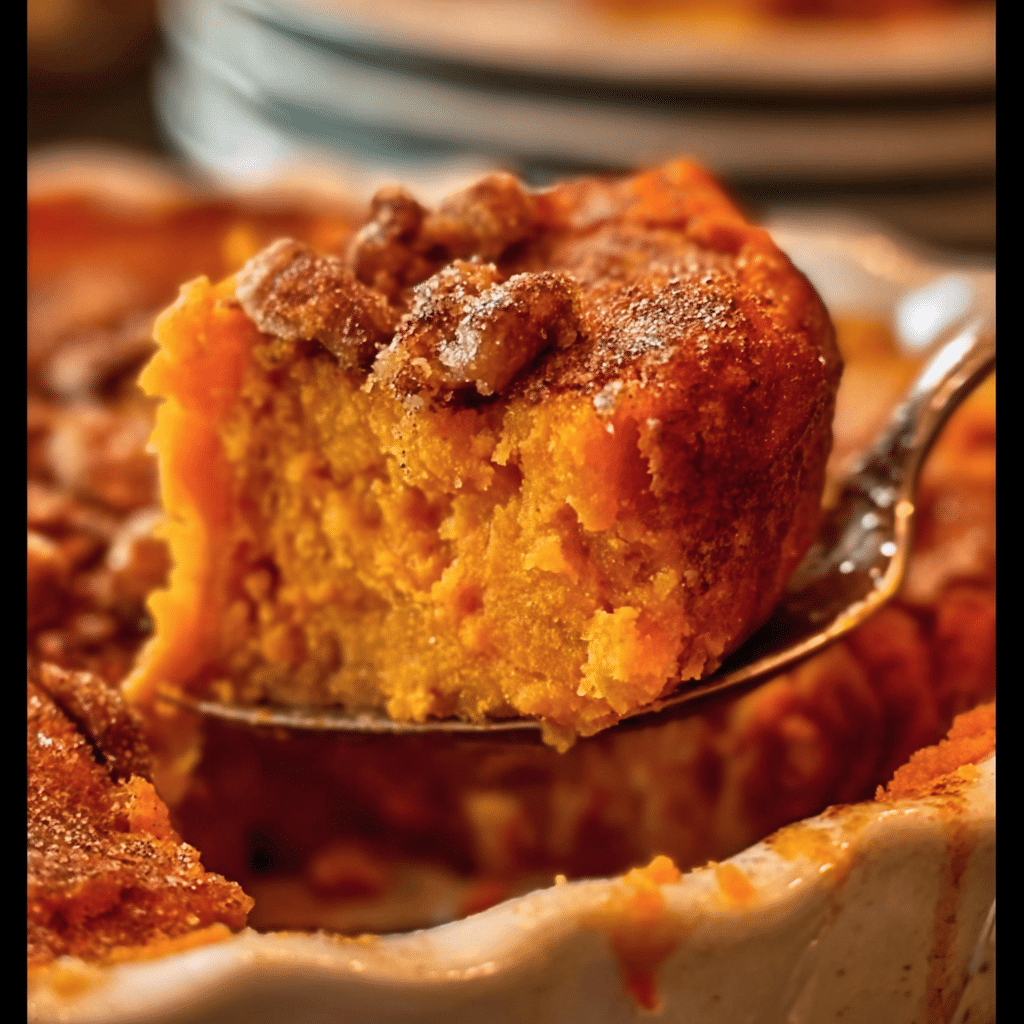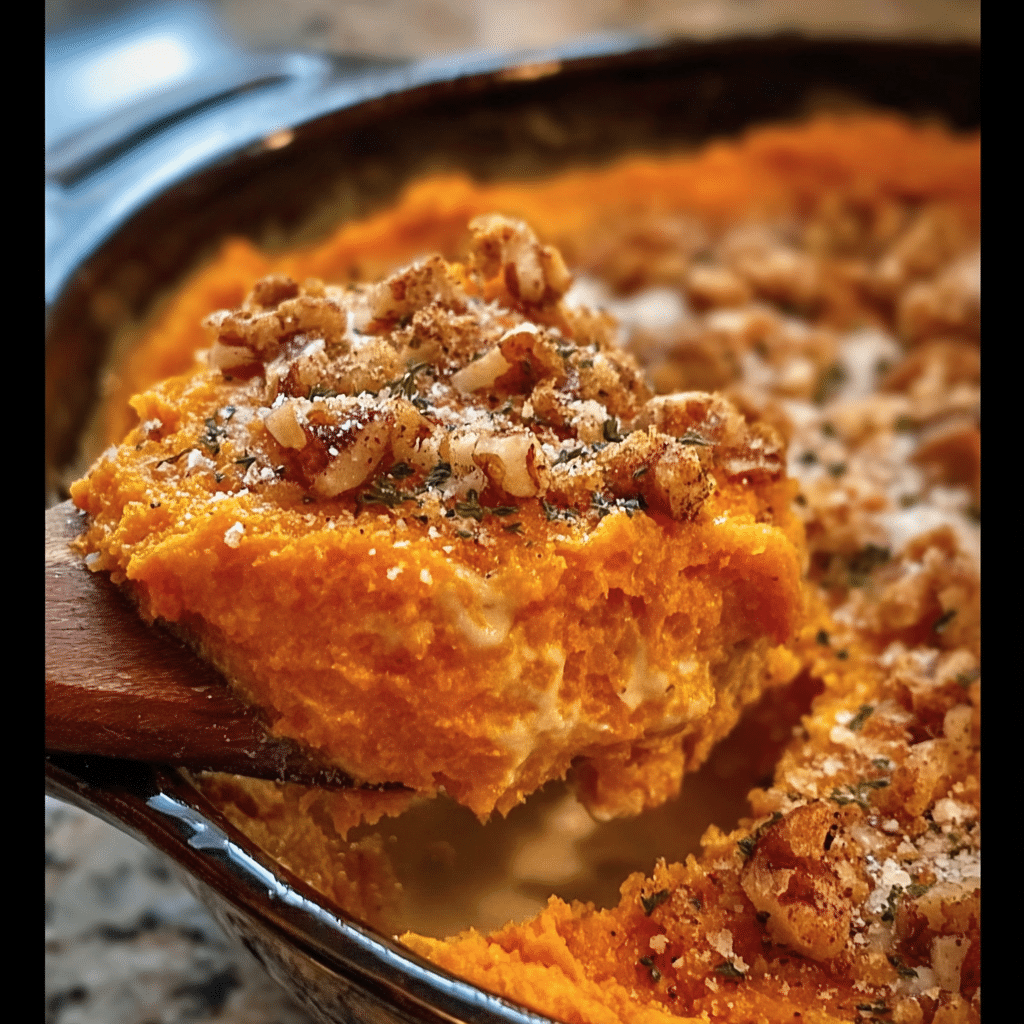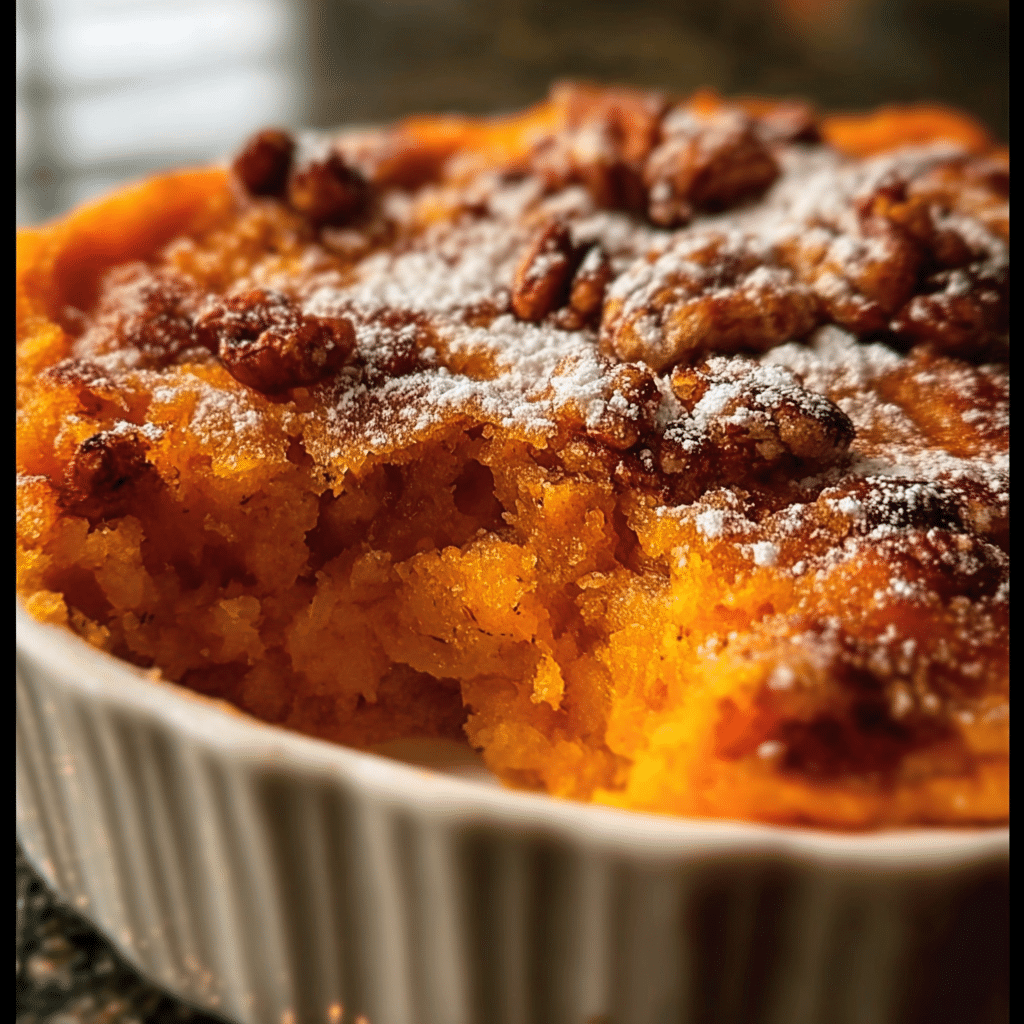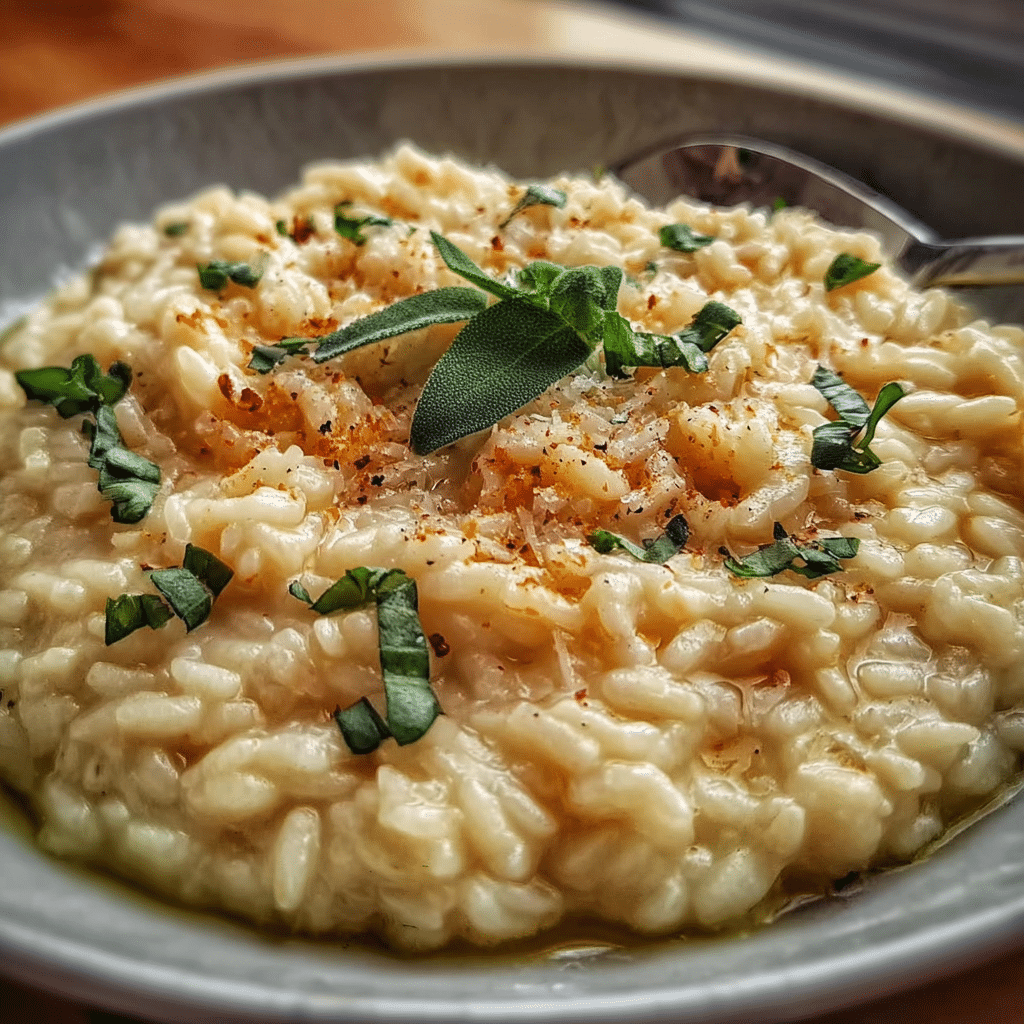Sweet potato souffle is not just a dish; it’s a celebration of flavor, nostalgia, and family gatherings. My journey with this delightful recipe began one chilly autumn evening when the air was crisp and the leaves were bursting with vibrant colors. I remember being at my grandmother’s house, where the warm scents of cinnamon and nutmeg mingled with the earthy aroma of roasted sweet potatoes. That was the first time I tasted her famous sweet potato souffle, and I was instantly hooked. The creamy texture, the subtle sweetness, and the warm spices created an experience that I still cherish today. It was a dish that brought everyone together around the dinner table, sparking laughter and stories that would weave into the fabric of our family history.
The sweet potato souffle has roots that run deep in American cuisine, particularly in the Southern United States. The dish itself is often associated with Thanksgiving and other festive occasions, but its origins trace back to the times when sweet potatoes were first cultivated by Native Americans. They recognized the tuber as a nutritious and versatile food source, and over the years, it became a staple in many households. As African slaves were brought to America, they incorporated sweet potatoes into their cooking, often mashing them with spices and other ingredients to create a comforting, hearty dish. This melding of cultures resulted in the sweet potato casserole we know today, with the souffle variation adding an element of lightness and airiness.

The Story Behind This Recipe
What makes my grandmother’s sweet potato souffle so special is the way she prepared it with love and care. She always said that the secret to a perfect souffle was to whip the sweet potatoes until they were fluffy and light, adding just the right amount of sugar and spices to enhance their natural sweetness. This technique gives the dish its signature texture, setting it apart from other sweet potato casseroles that can sometimes feel heavy or overly sweet.
This recipe is perfect for busy families who are looking for a quick dinner solution. With minimal prep time and the ability to prepare it in advance, this dish can easily fit into any weeknight meal plan. You can whip it up in about 30 minutes, pop it in the oven, and let it bake while you focus on other aspects of your dinner. Plus, it’s versatile enough to pair with a variety of proteins, making it a fantastic side dish that complements everything from roasted chicken to glazed ham.
Seasonally, sweet potato souffle shines brightest in the fall and winter months, especially during Thanksgiving and Christmas. However, I believe it’s a dish that can—and should—be enjoyed year-round. There’s something inherently comforting about sweet potatoes that warms the soul, making it a perfect choice for family dinners, potlucks, or even as a thoughtful gift to a neighbor in need of a home-cooked meal.
Emotionally, this dish connects me to my roots and family traditions. Every time I prepare it, I think of my grandmother’s warm smile and her gentle guidance in the kitchen. It reminds me of the importance of gathering around the table, sharing meals, and creating memories with loved ones. When I make this sweet potato souffle, I feel like I am honoring her legacy and keeping our family traditions alive.
In this guide, you will learn everything you need to know about making the perfect sweet potato souffle. From selecting the best sweet potatoes to whipping up the perfect blend of spices and techniques, I’ll share tips, tricks, and personal anecdotes to help you create a dish that will undoubtedly become a beloved part of your family’s culinary repertoire. So grab your mixing bowl and let’s dive into the delicious world of sweet potato souffle!
The Rich History and Cultural Significance of sweet potato souffle
The sweet potato souffle has a rich history that reflects the diverse cultures and culinary traditions of America. To truly appreciate this dish, it’s essential to explore its origins and how it has evolved over time. Sweet potatoes, known for their vibrant orange flesh and sweet flavor, are native to Central and South America. They were a staple food for Native American tribes long before European settlers arrived. The indigenous peoples cultivated sweet potatoes for their nutritional value, using them in various dishes, often roasting or boiling them to enhance their natural sweetness.
Origins and History
As sweet potatoes made their way into American cooking, they became especially popular in the Southern states, where they thrived in the warm climate. The first recorded recipe for sweet potato souffle appeared in the 19th century, often labeled as a “pudding” or “casserole.” This early version was typically made by mashing sweet potatoes with sugar, milk, and spices, then baking them in a pie dish. Over the years, the addition of whipped egg whites became popular, giving the dish its airy, souffle-like texture.
Regional variations of sweet potato souffle exist, with each region adding its unique twist to the traditional recipe. In the South, you might find versions that incorporate pecans or marshmallows, while in New England, some recipes include a hint of maple syrup for added sweetness. These variations showcase the adaptability of the dish, allowing it to evolve while still remaining true to its roots.
Cultural Significance
The cultural significance of sweet potato souffle cannot be overstated. It has become a staple at holiday gatherings, particularly during Thanksgiving, where it is often served alongside turkey and cranberry sauce. The dish symbolizes not just nourishment but also the coming together of family and friends to celebrate gratitude and abundance. In African American culture, sweet potato dishes often have deep roots, representing resilience and creativity in the face of adversity. They connect generations through shared recipes passed down from ancestors who faced challenges yet found joy in their culinary creations.
Famous chefs and restaurants have also embraced sweet potato souffle, elevating it to new heights. For instance, renowned Southern chefs have added gourmet flair to the dish by incorporating unique ingredients like bourbon or gourmet spices. These modern takes not only preserve the traditional essence but also introduce new flavors that resonate with contemporary palates.
Nutritional Benefits
Aside from its rich history and cultural significance, sweet potato souffle also boasts numerous nutritional benefits. Sweet potatoes are an excellent source of vitamins A and C, both of which are essential for maintaining a healthy immune system. They are high in fiber, which aids digestion, and their natural sweetness means they can satisfy sugar cravings without the need for added sugars. When made with wholesome ingredients, sweet potato souffle can be a nutritious side dish that complements a balanced diet.
In conclusion, the sweet potato souffle is more than just a side dish; it is a cultural treasure that has evolved through time, embodying the spirit of community and celebration. Its versatility and nutritional benefits make it a dish that can fit into any meal, while its rich history connects us to our past. Whether you’re serving it at a holiday feast or enjoying it on a cozy weeknight, sweet potato souffle has the power to bring warmth and joy to your table.
Essential Ingredients for Perfect sweet potato souffle
Essential Ingredients for Perfect Sweet Potato Souffle
Creating a delightful sweet potato souffle starts with selecting the right ingredients. Each component plays a crucial role in achieving that perfect balance of flavor and texture that makes this dish a beloved favorite at family gatherings and holiday feasts. Let’s dive into the essential ingredients you will need, along with why they matter and how to choose the best options.
Essential Ingredients
- 3 cups of mashed sweet potatoes (about 3-4 medium sweet potatoes)
- ½ cup of granulated sugar
- ¼ cup of unsalted butter, melted
- ½ cup of whole milk
- 3 large eggs
- 1 teaspoon of vanilla extract
- 1 teaspoon of ground cinnamon
- ½ teaspoon of ground nutmeg
- 1 teaspoon of baking powder
- Pinch of salt
- 1 cup of mini marshmallows (optional, for topping)
Let’s break down each ingredient to understand its significance:
- Sweet Potatoes: The star of our souffle! Look for firm, smooth-skinned sweet potatoes without any blemishes. They should be vibrant orange inside, as that indicates a sweeter flavor. When mashed, they provide the creamy base that gives the souffle its characteristic texture.
- Sugar: This ingredient helps to enhance the natural sweetness of the sweet potatoes. Granulated sugar is typically used, but you can also experiment with brown sugar for a richer flavor.
- Unsalted Butter: Butter adds a rich, creamy texture. Using unsalted butter allows you to control the salt in your dish. Make sure it’s melted for easy incorporation.
- Whole Milk: This is crucial for achieving the right consistency. Whole milk adds creaminess; however, you can opt for alternatives like almond or oat milk if you have dietary restrictions.
- Eggs: Eggs act as a binder and help the souffle rise, creating that light, fluffy texture. Fresh eggs are always the best choice.
- Vanilla Extract: Enhances the overall flavor profile, adding a subtle sweetness that complements the sweet potatoes.
- Ground Cinnamon and Nutmeg: These warm spices bring depth to the dish and are traditional in sweet potato preparations. Use freshly ground spices if possible for the most aromatic experience.
- Baking Powder: This leavening agent helps the souffle rise, giving it the airy texture that is characteristic of a good souffle.
- Salt: A pinch of salt balances the sweetness and enhances the overall flavor.
- Mini Marshmallows (optional): These are often used as a nostalgic topping that caramelizes slightly when baked, adding sweetness and a fun texture.

Sweet Potato Souffle Casserole Recipe
Ingredients
Sweet potatoes:
- 4 medium-sized sweet potatoes*, about 2.75 pounds
- ¼ cup granulated sugar
- ¼ cup light brown sugar, packed
- 2 large eggs
- ½ cup cream, half and half, or whole milk
- 4 tablespoons unsalted butter, melted
- 1½ teaspoons pure vanilla extract
- ½ teaspoon salt
Topping:
- 1 cup light brown sugar, packed
- ½ cup all purpose flour
- ½ teaspoon ground cinnamon
- couple pinches salt
- ½ cup finely chopped pecans, optional, but highly recommended
- 4 tablespoons unsalted butter, softened
Instructions
Sweet potatoes:
- Preheat oven to 350°F. Lightly grease an 8×8 baking dish and set aside.
- Peel and chop the sweet potatoes (you should have around 10 cups). Place in a large pot, cover with water, and boil until tender (about 7 minutes, depending on the size). Drain well, return to the pot, and mash the potatoes. You should have around 4 cups of mashed sweet potatoes.
- Whisk granulated sugar, brown sugar, eggs, cream/milk, melted butter, vanilla and salt. Add the egg mixture and the mashed sweet potatoes to a large mixing bowl or the bowl of a food processor. Mix with a hand mixer (or process with a food processor) until the mixture is smooth and combined. Pour the potatoes into the baking dish.
Topping:
- Combine brown sugar, flour, cinnamon, salt, and pecans (I use a fork). Add softened butter and use your fingers to blend the butter into the flour mixture until well combined (it should resemble wet sand).
- Sprinkle the topping over the sweet potatoes and bake in the middle of the oven for 30-40 minutes, until the topping is golden brown.
Shopping Tips
When shopping for ingredients, consider buying fresh produce from local farmer’s markets, especially during peak season from late summer to early winter. Organic sweet potatoes are a great option as they are grown without harmful pesticides, which is better for both your health and the environment. Check for firmness and avoid any that feel soft or have blemishes. For other ingredients like eggs and dairy, look for local or organic sources to ensure freshness. Always check the expiration dates on milk and eggs to guarantee quality.
Substitutions and Alternatives
If you’re facing dietary restrictions or simply want to experiment with flavors, here are some alternatives:
- Sweet Potatoes: If you can’t find sweet potatoes, butternut squash or pumpkin can be used as substitutes, though they will yield slightly different flavors.
- Sugar: For a healthier option, you can use honey or maple syrup, but be aware that these will alter the liquid ratios slightly, so adjust accordingly.
- Milk: Non-dairy milk like almond, coconut, or oat milk can be substituted to make the dish vegan or lactose-free.
- Eggs: For a vegan version, you can replace each egg with ¼ cup of unsweetened applesauce or a flaxseed egg (1 tablespoon of flaxseed meal mixed with 2.5 tablespoons of water).
- Butter: Coconut oil or vegan butter can be used in place of regular butter for a dairy-free option.
Once you’ve gathered all your ingredients, store them properly to maintain freshness. Sweet potatoes can be kept in a cool, dark place for a few weeks. Milk and eggs should be stored in the refrigerator and used before their expiration dates. Spices, including cinnamon and nutmeg, should be stored in airtight containers in a cool, dry place to retain their potency.
In conclusion, the right ingredients are fundamental in crafting a perfect sweet potato souffle. Taking the time to choose quality ingredients will not only enhance the flavor of your dish but also make the cooking process more enjoyable. Whether you are making this dish for a holiday or just to savor a comforting family recipe, these tips will help you create a delightful experience in your kitchen.
Detailed Step-by-Step sweet potato souffle Cooking Instructions
Detailed Step-by-Step Sweet Potato Souffle Cooking Instructions
Now that we have gathered all our essential ingredients, it’s time to roll up our sleeves and get cooking! A sweet potato souffle is not only delicious but also a visually stunning dish that will impress your family and friends. Below, I’ll guide you through each step of the cooking process, ensuring your souffle turns out perfectly fluffy and flavorful.
Preparation Steps
Before diving into the cooking process, let’s prepare our workspace and ingredients:
- Preheat the Oven: Start by preheating your oven to 350°F (175°C). This is crucial, as the souffle needs a hot environment to rise properly.
- Wash and Peel the Sweet Potatoes: Rinse the sweet potatoes under running water to remove any dirt. Peel them using a vegetable peeler, revealing the vibrant orange flesh underneath.
- Cut into Chunks: Cut the sweet potatoes into uniform chunks, about 1 to 2 inches in size. This ensures that they cook evenly and mash easily.
- Boil the Sweet Potatoes: Place the sweet potato chunks in a large pot, cover them with water, and add a pinch of salt. Bring the water to a boil and let the potatoes cook for about 15-20 minutes, or until they are fork-tender. They should be soft enough to mash easily.
- Drain and Mash: Once cooked, drain the sweet potatoes and return them to the pot. Mash them using a potato masher or a fork until smooth. You can also use a food processor for a creamier texture, but be careful not to over-process them.
Cooking Process
With our sweet potatoes ready, let’s move on to creating the souffle mixture:
- Mix Sugar and Butter: In a large mixing bowl, combine the melted butter and granulated sugar. Whisk them together until well blended. This step helps to cream the butter and sugar, ensuring a smooth consistency.
- Add Eggs: Crack the eggs into the bowl with the butter and sugar mixture. Beat them in until fully incorporated. This will add richness and help with the souffle’s lift.
- Incorporate the Sweet Potatoes: Gradually add the mashed sweet potatoes to the mixture. Stir until everything is well combined. You’ll notice the vibrant orange color coming through, which is a sure sign of deliciousness!
- Add Milk and Spices: Pour in the whole milk, followed by the vanilla extract, ground cinnamon, nutmeg, baking powder, and a pinch of salt. Mix until everything is evenly distributed and creamy.
- Taste and Adjust: Here’s a chef’s secret: taste your mixture! Adjust the sweetness or spice levels to your liking. This is your souffle, after all!
Final Assembly
It’s time to bring everything together and prepare for baking:
- Grease the Baking Dish: Lightly grease a 2-quart casserole dish or souffle dish with butter or non-stick spray. This will help the souffle rise without sticking.
- Pour the Mixture: Carefully pour the sweet potato mixture into the prepared baking dish, smoothing the top with a spatula. If you’re using mini marshmallows, sprinkle them over the top for a fun and sweet finish.
- Bake: Place the dish in the preheated oven and bake for approximately 30 minutes. You’ll know it’s ready when the edges are set, and the top is golden brown.
- Check for Doneness: Insert a toothpick into the center; it should come out clean or with just a few moist crumbs. If it’s too wet, give it a few more minutes.
- Cool and Serve: Once done, remove the souffle from the oven and let it cool for about 10 minutes before serving. This will allow it to set slightly and make it easier to slice.
Throughout this cooking process, keep an eye on your souffle; the rising and browning is a beautiful sight. As it bakes, the aroma of sweet spices will fill your kitchen, creating a comforting atmosphere. Remember, the key to a successful sweet potato souffle is in the details: from preheating the oven to the final assembly, each step contributes to the overall flavor and texture.
And there you have it! A delectable sweet potato souffle that is perfect for any occasion. Whether it’s a holiday feast or a family dinner, this dish is sure to be a crowd-pleaser. Enjoy every bite, and don’t forget to share your experience with loved ones—after all, cooking is more than just about food; it’s about creating memories together.
Professional Tips and Techniques for sweet potato souffle
When it comes to creating the perfect sweet potato souffle, mastering the art of this dish can elevate your culinary skills and impress your family and friends. This delightful casserole, characterized by its creamy texture and sweet flavor, is a holiday staple in many homes. However, achieving the perfect souffle can be a bit tricky. Here, I’ll share some professional tips and techniques that will help you navigate the intricacies of this beloved dish.
Professional Techniques
One essential aspect of making a successful sweet potato souffle is understanding the importance of ingredient quality and preparation. Start with fresh, high-quality sweet potatoes; they should be firm and free of blemishes. The first step is to cook the sweet potatoes until they are tender. You can either boil, bake, or microwave them. Baking tends to enhance their natural sweetness, while boiling can sometimes dilute their flavor. I personally prefer baking them as it caramelizes the sugars and brings out the sweet notes.
Once your sweet potatoes are cooked, allow them to cool slightly before peeling. A handy trick I learned is to use a stand mixer to whip the sweet potatoes until they are smooth and creamy. This not only saves time but ensures an even consistency. If you prefer a more rustic texture, a simple potato masher will suffice. Remember, lumps in your mixture can lead to an uneven souffle.
Incorporating air into the batter is crucial for achieving that light, fluffy texture we all love in a sweet potato souffle. To do this, separate your eggs; beat the egg whites until stiff peaks form and gently fold them into your sweet potato mixture. This technique can be a little daunting at first, but don’t rush it! Folding should be done carefully to maintain the airiness.
Another pro tip is to bake your souffle in a water bath, or bain-marie, which helps regulate the cooking temperature and prevents the souffles from cracking. Place your filled casserole dish into a larger pan and add hot water to the outer pan until it reaches halfway up the sides of the souffle dish. This method is a game-changer for achieving that coveted smooth top.
Troubleshooting Guide
Even the most experienced cooks encounter issues from time to time. If your sweet potato souffle collapses after baking, it could be due to a few factors. One common mistake is overmixing the batter after adding the egg whites, which can deflate them. Remember to fold gently! Additionally, if your souffle doesn’t rise as expected, ensure that your baking powder is fresh and that your oven is preheated to the correct temperature.

If your souffle comes out too dense, try increasing the amount of whipped egg whites or adding a touch more milk or cream for a lighter texture. On the other hand, if it ends up too sweet, balance it out with a pinch of salt or a bit of lemon juice to enhance the flavor.
Presentation Tips
Presentation is key when it comes to serving your sweet potato souffle. Once baked, the souffle should have a beautiful golden-brown top. For an elegant touch, sprinkle some chopped pecans or marshmallows on top during the last few minutes of baking. This not only adds flavor but creates a visually appealing contrast. Serve it in a beautiful dish that complements your table setting, and don’t forget to garnish with a sprinkle of cinnamon or fresh herbs like rosemary for an aromatic finish.
Pairing your souffle with the right beverage can elevate your meal. A sweet dessert wine, such as a late-harvest Riesling or a sparkling Moscato, pairs beautifully with the flavors of sweet potato souffle. If you prefer something non-alcoholic, consider a spiced apple cider or a refreshing ginger ale. Both will complement the dish’s sweet and savory notes beautifully.
Meal prep is another great way to enjoy this dish without the stress. You can prepare the sweet potato mixture a day in advance, store it in the fridge, and bake it just before serving. This not only saves you time but allows the flavors to meld together beautifully overnight. You can also scale the recipe up or down depending on your guest list, making it a versatile dish for any gathering.
Creative Variations and Adaptations of sweet potato souffle
The beauty of the sweet potato souffle lies in its versatility. While the classic version is always a hit, there are countless ways to put a creative spin on this dish. Whether you’re looking to adapt it for dietary needs or simply want to try something new, the possibilities are endless!
Seasonal Variations
Sweet potatoes are available year-round, but certain seasonal ingredients can elevate your sweet potato souffle to the next level. For a fall twist, consider adding spices like nutmeg or allspice, or incorporating maple syrup for a deeper sweetness. In the summer, you might mix in fresh herbs like basil or mint for a refreshing touch.
Another seasonal variation could include the use of pumpkin puree during autumn. Mixing equal parts sweet potato and pumpkin not only adds a unique flavor but also changes the color to a vibrant orange, making it visually stunning on your holiday table.
Dietary Adaptations
For those with dietary restrictions, adapting the sweet potato souffle is easier than you might think! If you’re looking for a vegan option, substitute eggs with flaxseed meal mixed with water or use aquafaba (the liquid from canned chickpeas) as a binding agent. You can also use coconut milk instead of dairy for a rich, creamy texture.
Gluten-free? Simply ensure that all your ingredients, including the baking powder, are certified gluten-free. For those following a keto diet, you might opt for alternatives like cauliflower puree mixed with a small amount of sweet potato to reduce the overall carb content while maintaining a similar flavor profile.
Creative Twists
Don’t be afraid to get creative with flavor profiles! Consider adding a savory twist to your sweet potato souffle by incorporating ingredients like goat cheese or crumbled feta. The tanginess of these cheeses balances the sweetness perfectly, creating a sophisticated dish that’s sure to impress. You could also experiment with spices such as chipotle or smoked paprika for a smoky flavor that pairs beautifully with sweet potatoes.
If you have leftovers, think outside the box! Transform your sweet potato souffle into breakfast by mixing it into pancake batter, or use it as a filling for savory crepes. You can even bake it into muffins or fritters, giving new life to your leftovers while minimizing waste.
Lastly, various cooking methods can bring different textures and flavors to your sweet potato souffle. If you’re short on time, consider using a slow cooker for a more hands-off approach. Just mix your ingredients, set the cooker on low, and let it do the work! This method yields a wonderfully soft and creamy souffle that’s perfect for busy days.
In conclusion, the sweet potato souffle is a dish that can be tailored to suit any palate, occasion, or dietary need. With these variations and adaptations, your culinary creativity can shine, ensuring this timeless dish remains a staple in your kitchen for years to come.
Storage, Reheating, and Meal Prep for sweet potato souffle
When it comes to preparing a delicious sweet potato souffle, one of the most important aspects to consider is storage. Whether you’re making it for a special occasion, a holiday gathering, or simply to enjoy throughout the week, knowing how to properly store and reheat your casserole can make all the difference in maintaining its flavor and texture.
Short-term Storage
If you’ve just whipped up a fresh batch of sweet potato souffle, the first thing you want to do is let it cool down to room temperature. This step is crucial because placing a hot casserole directly into the refrigerator can create condensation, leading to sogginess. Once cooled, transfer your souffle into an airtight container. Glass containers are a fantastic option because they are non-reactive and won’t absorb odors, ensuring your casserole retains its original flavor.
For short-term storage in the refrigerator, your sweet potato souffle can last for about 3 to 5 days. Just make sure to cover it tightly with a lid or plastic wrap to prevent it from drying out. If you’re someone who enjoys meal prepping, this is a great dish to make ahead of time. You can prepare the casserole, store it in the fridge, and simply reheat it when you’re ready to enjoy it.
Freezing and Long-term Storage
Now, if you find yourself with more sweet potato souffle than you can eat within a week, don’t fret! This dish freezes beautifully. To freeze, follow the same cooling process as before, then portion the casserole into smaller servings. This way, you can take out only what you need without having to defrost the entire dish.
Use freezer-safe containers or heavy-duty aluminum foil to wrap the portions tightly. If you opt for freezer bags, try to remove as much air as possible before sealing to prevent freezer burn. Properly stored, your sweet potato souffle can last up to 3 months in the freezer. Just remember to label your containers with the date so you can keep track of their freshness.
When you’re ready to enjoy a frozen portion, the best method is to transfer it to the refrigerator to thaw overnight. This slow thawing helps maintain the texture of the casserole. If you’re short on time, you can use the defrost setting on your microwave, but be cautious as this can sometimes lead to uneven heating.
Reheating Best Practices
Reheating your sweet potato souffle can be a bit tricky, but with the right approach, you can bring it back to life without compromising its creamy texture. If reheating from the refrigerator, you can simply place the casserole in a preheated oven at 350°F (175°C) for about 20-30 minutes, or until heated through. Covering the dish with aluminum foil will help keep moisture in, preventing it from drying out.
If you’re reheating a frozen portion, it’s best to thaw it first as mentioned earlier. Once thawed, follow the same reheating instructions. For those who prefer a quicker method, you can also reheat individual portions in the microwave. Just be sure to cover the dish to trap steam and heat it in short bursts, stirring in between to ensure even heating.

When it comes to meal prep and batch cooking, sweet potato souffle is an excellent option. You can prepare multiple servings in advance and have a nutritious side dish ready to go. Just remember to follow the storage and reheating guidelines carefully to ensure you’re enjoying it at its best.
Finally, it’s essential to keep food safety in mind. Always ensure that your casserole is stored at the appropriate temperature; the refrigerator should be at or below 40°F (4°C) and the freezer at 0°F (-18°C). If you notice any off smells, discoloration, or texture changes, it’s best to err on the side of caution and discard the dish.
In conclusion, proper storage and reheating techniques are key to enjoying your sweet potato souffle to its fullest potential. Whether you’re planning to indulge in it over the next few days or save some for later, these tips will help you retain its delicious flavor and creamy consistency.
Nutritional Benefits and Health Information
When we talk about comfort food, few dishes can compare to the rich, creamy delight of a sweet potato souffle. Not only is it a favorite at family gatherings and holiday feasts, but it also comes packed with nutritional benefits that make it a guilt-free indulgence. Let’s dive into the nutritional profile and health benefits of this beloved dish.
Nutritional Profile
A typical serving of sweet potato souffle can vary depending on the specific recipe, but it generally features sweet potatoes, eggs, sugar, and butter or other fat. A standard serving (about 1 cup) can contain around 300 calories. The macronutrient breakdown is typically as follows:
- Carbohydrates: Sweet potatoes are naturally rich in carbohydrates, providing around 60 grams per serving. These carbs are a great source of energy, particularly for those following an active lifestyle.
- Protein: You can expect about 5-7 grams of protein per serving, primarily from the eggs and any additional protein sources you may incorporate.
- Fats: Depending on how much butter or cream is used, fat content can range from 10-15 grams, with a balance of saturated and unsaturated fats.
Moreover, sweet potatoes are a fantastic source of dietary fiber, contributing to digestive health and promoting a feeling of fullness. Each serving can provide around 4 grams of fiber, which is about 15% of the recommended daily intake for adults.
Health Benefits
The health benefits of the key ingredients in sweet potato souffle are numerous. Sweet potatoes themselves are incredibly nutritious. They are loaded with vitamins and minerals, particularly vitamin A, which is essential for eye health and immune function. One serving of sweet potato can provide over 400% of your daily vitamin A needs. They also contain significant amounts of vitamin C, which supports skin health and aids in the absorption of iron.
Additionally, sweet potatoes are rich in antioxidants, which help combat oxidative stress in the body. The vibrant orange color of sweet potatoes comes from beta-carotene, a powerful antioxidant that has been linked to reduced inflammation and a lower risk of chronic diseases.
Moreover, the inclusion of eggs adds another layer of nutrition, contributing essential amino acids and healthy fats. Eggs are known for being a complete protein source, meaning they contain all the essential amino acids your body cannot produce on its own. They also provide choline, which is vital for brain health and development.
Dietary Considerations
When it comes to dietary considerations, sweet potato souffle can fit into many different eating plans. For those following a vegetarian diet, this dish is a delightful side that can accompany any main course. However, for vegans or those with egg allergies, modifications can easily be made. You could substitute eggs with flaxseed meal or applesauce, and use plant-based butter or coconut oil in place of traditional butter.
For gluten-free diets, this casserole is naturally gluten-free, making it a great option for those with celiac disease or gluten sensitivities. Just be mindful of any added ingredients, such as certain types of sugar or toppings, which may contain gluten.
In terms of calorie content, while a traditional sweet potato souffle may be higher in sugar due to the addition of brown sugar or maple syrup, you can easily modify the recipe by reducing the amount of sweetener or using natural alternatives like honey or agave syrup. By doing so, you can create a healthier version without sacrificing flavor.
When compared to similar dishes like mashed potatoes or traditional casseroles, sweet potato souffle often comes out ahead in terms of nutritional value. Sweet potatoes themselves offer a lower glycemic index than regular potatoes, meaning they won’t cause as rapid a spike in blood sugar levels.
In summary, sweet potato souffle isn’t just a delicious treat; it also provides a wealth of nutritional benefits. With its rich array of vitamins, minerals, and fiber, this dish can be a great addition to your diet, whether enjoyed during the holidays or as an everyday side. So, the next time you whip up a batch, you can feel good knowing that you’re indulging in something nutritious and satisfying!
Frequently Asked Questions About Sweet Potato Souffle
What is a sweet potato souffle casserole recipe?
A sweet potato souffle casserole is a delightful and creamy dish made primarily from sweet potatoes, which are whipped to a fluffy texture and combined with ingredients like eggs, sugar, butter, and milk. To make this recipe, you’ll typically start by boiling or baking the sweet potatoes until tender, then mashing them and mixing them with the remaining ingredients. For added flavor, consider incorporating spices like cinnamon or nutmeg, and a splash of vanilla extract. Baking the souffle in a greased casserole dish allows it to rise and develop a light, airy texture, creating a perfect side dish for holiday meals or family gatherings.
How do I make sweet potato souffle casserole with marshmallows?
To make a sweet potato souffle casserole with marshmallows, begin by preparing your sweet potato mixture as you would for a traditional souffle. After mixing the mashed sweet potatoes with eggs, sugar, and spices, pour the mixture into a greased casserole dish. The key step is to top the sweet potato mix with a generous layer of mini marshmallows before baking. As the casserole bakes, the marshmallows will melt and toast, creating a sweet and gooey topping that contrasts beautifully with the fluffy sweet potato base.
What is an old fashioned sweet potato souffle casserole?
An old fashioned sweet potato souffle casserole typically features classic ingredients and preparation methods that evoke nostalgia for traditional southern cooking. This version often includes simple, wholesome ingredients like butter, brown sugar, and eggs, combined with boiled or baked sweet potatoes. Many recipes also call for milk or cream to enhance the creaminess of the dish. To achieve that old fashioned flair, consider adding pecans or walnuts for a crunchy topping, and don’t forget to bake it until it’s golden brown and puffed up for the best texture and flavor.
What is an easy sweet potato souffle casserole recipe?
An easy sweet potato souffle casserole recipe is all about simplicity and efficiency without compromising on flavor. Start by using canned sweet potatoes or pre-cooked fresh sweet potatoes to save time. Mash them and mix with basic ingredients like eggs, sugar, and melted butter, then pour the mixture into a casserole dish. For a quick baking option, you can use a store-bought topping like crushed graham crackers or even marshmallows to finish it off. This approach allows anyone, even beginner cooks, to whip up a delicious sweet potato souffle casserole with minimal effort.
Conclusion: Mastering the Perfect sweet potato souffle
Creating the perfect sweet potato souffle is more than just following a recipe—it’s about understanding the techniques, ingredients, and cultural significance behind this beloved dish. Throughout this comprehensive guide, we’ve explored everything from the historical origins to modern variations, ensuring you have all the knowledge needed to make this recipe your own.
Whether you’re a beginner cook or an experienced chef, the techniques and tips we’ve shared will help you create a sweet potato souffle that’s not only delicious but also meaningful. Remember that cooking is a journey of discovery, and each time you make this dish, you’ll learn something new.
We encourage you to experiment with the variations we’ve discussed, adapt the recipe to your dietary needs, and most importantly, share it with the people you love. Food has the incredible power to bring people together, and Sweet Potato Souffle Casserole is the perfect dish to create lasting memories around your dinner table.





